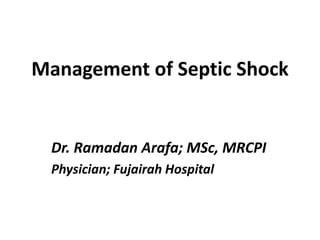The document provides a comprehensive overview of septic shock, its incidence, symptoms, and pathophysiology, emphasizing its prevalence as a leading cause of mortality in intensive care units. It details the diagnostic criteria for sepsis syndromes and outlines management strategies, including early recognition, antibiotic therapy, hemodynamic resuscitation, and continuous monitoring of vital signs to improve patient outcomes. The document also describes the various complications associated with septic shock and emphasizes the importance of source control and fluid management in treatment.








































































